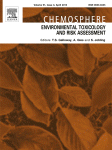Application of a silicone rubber passive sampling technique for monitoring PAHs and PCBs at three Belgian coastal harbours
Application of a silicone rubber passive sampling technique for monitoring PAHs and PCBs at three Belgian coastal harbours
 A 4-year monitoring study - coordinated by our lab - was performed to examine the freely dissolved water concentrations of PAHs and PCBs in three coastal harbours and at an offshore station in the North Sea. The results are part of a more extensive study to provide information on occurrence, distribution and effects of pollutants in the Belgian coastal zone. In the present study silicone rubber passive samplers were used. We found that the non-linear least-square (NLS) method proved to be suitable for estimating sampling rates when using the following performance reference compounds: fluorene-d10, phenanthrene-d10, fluoranthene-d10, benzo(e)pyrened12, coronene-d12, CB10, CB14, CB50, CB104, CB145 and CB204. The application of two NLS methods for estimating the sampling rate (Rs) resulted in significant differences for freely dissolved concentrations for individual compounds of up to 30% between the two methods. A model that takes into account the decrease of sampling rate for compounds with higher molecular weight should give a more accurate Rs and was the preferred estimation method. Rs varied from 0.9 to 34.8 L/d for the different target compounds, while estimated freely dissolved concentrations for sum 15 PAHs varied between 3.9 and170 ng/L and for sum 14 PCBs between 0.030 and 3.1 ng/L. The stations located within marinas showed the highest level of contamination, while the offshore station (5 mile from coastline) exhibited the lowest level. The implications of the use of passive samplers for monitoring programs are discussed.
A 4-year monitoring study - coordinated by our lab - was performed to examine the freely dissolved water concentrations of PAHs and PCBs in three coastal harbours and at an offshore station in the North Sea. The results are part of a more extensive study to provide information on occurrence, distribution and effects of pollutants in the Belgian coastal zone. In the present study silicone rubber passive samplers were used. We found that the non-linear least-square (NLS) method proved to be suitable for estimating sampling rates when using the following performance reference compounds: fluorene-d10, phenanthrene-d10, fluoranthene-d10, benzo(e)pyrened12, coronene-d12, CB10, CB14, CB50, CB104, CB145 and CB204. The application of two NLS methods for estimating the sampling rate (Rs) resulted in significant differences for freely dissolved concentrations for individual compounds of up to 30% between the two methods. A model that takes into account the decrease of sampling rate for compounds with higher molecular weight should give a more accurate Rs and was the preferred estimation method. Rs varied from 0.9 to 34.8 L/d for the different target compounds, while estimated freely dissolved concentrations for sum 15 PAHs varied between 3.9 and170 ng/L and for sum 14 PCBs between 0.030 and 3.1 ng/L. The stations located within marinas showed the highest level of contamination, while the offshore station (5 mile from coastline) exhibited the lowest level. The implications of the use of passive samplers for monitoring programs are discussed.
Full reference (link)
Monteyne E, Roose R, Janssen CR. 2013. Application of a silicone rubber passive sampling technique for monitoring PAHs and PCBs at three Belgian coastal harbours. Chemosphere 91:390-398.
